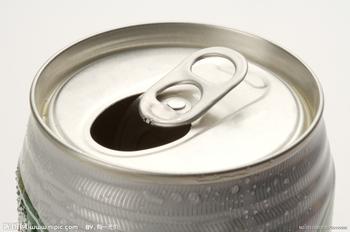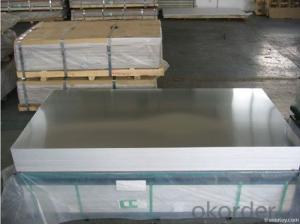Aluminum Pvc Plain Sheets for Aluminium Can Stock and Caps Using Aluminum Foil
- Loading Port:
- Shanghai
- Payment Terms:
- TT OR LC
- Min Order Qty:
- 5 m.t.
- Supply Capability:
- 300 m.t./month
OKorder Service Pledge
OKorder Financial Service
You Might Also Like
Aluminium (or aluminum; see spelling differences) is a chemical element in the boron group with symbol Al and atomic number 13. It is a silvery white, soft, nonmagnetic, ductile metal. Aluminium is the third most abundant element (after oxygen and silicon), and the most abundant metal in the Earth's crust. It makes up about 8% by weight of the Earth's solid surface.
Aluminium metal is so chemically reactive that native specimens are rare and limited to extreme reducing environments. Instead, it is found combined in over 270 different minerals.The chief ore of aluminium is bauxite.
Aluminium is remarkable for the metal's low density and for its ability to resist corrosion due to the phenomenon of passivation. Structural components made from aluminium and its alloys are vital to the aerospace industry and are important in other areas of transportation and structural materials. The most useful compounds of aluminium, at least on a weight basis, are the oxides and sulfates.
ALLOY:AA3104,AA5182,AA5052
TEMPER:H19,H48
THICKNESS:0.26-0.29mm
WIDTH:700-1800mm( body stock),60-1800mm(end&tab stock)
PAINT:PPG OR VALSPAR
LUBRICATION:HENKEL
Special specification is available on customer's requirement
SURFACE QUALITY: GOOD APPEARANCE WITH NO-CRACK AND
WELL-DISTRIBUTE GRAIN.
BUILD UP: TIGHT SLIT EDGES FREE FROM CRACKS, LAYER TO
LAYER SHIFT NOT MORE THAN 2MM.
PROFILE: -0/+1%
FLATNESS: MILL FLATNESS COIL HAVING EDGE WAVINESS
RATHER THAN CENTER BUCKLES SHALL BE ACCEPTABLE.
ROLLING PERFORMANCE: RE-ROLLABLE TO THE FINAL DESIRES
GAUGES
- Q: Are the aluminum sheets suitable for manufacturing aircraft fuselages?
- Indeed, the utilization of aluminum sheets is appropriate for the production of aircraft fuselages. Aluminum remains a favored selection for aircraft assembly owing to its exceptional strength-to-weight proportion, ability to withstand corrosion, and simplicity in fabricating. Its lightweight nature aids in the reduction of the aircraft's total weight, thereby enhancing fuel efficiency and augmenting payload capacity. Moreover, aluminum exhibits remarkable resilience in enduring the pressures and tensions encountered during flight. Furthermore, it is a readily accessible and economically viable material, rendering it a pragmatic preference for aircraft manufacturers.
- Q: i need to know these things please....can aluminium withstand the forces of being in a cargo hold on a air freight, can it withstand extreme temps and to what extent an is it microwavable?? please help me
- No metals are microwavable, they will ruin any microwave oven by producing sparks. Even ceramic plates with a little metallic paint eg of silver will spark. Aluminium on its own has little strength but when mixed with small amounts of eg copper or manganese it aquires great strength while remaining light. In addition it has the advantage of being very resistant to oxidation and corrosion. It is certainly used extensively in aircraft construction. Due to being non toxic it used to make cans for beers, soft drinks (sodas) etc However it doesn't stand up well to high temperatures, its melting point is just at 660 degrees celsius, by comparison for iron it is 1540 and tungsten 3420.
- Q: Can the aluminum sheets be used for manufacturing heat sinks?
- Yes, aluminum sheets can be used for manufacturing heat sinks.
- Q: Can the aluminum sheets be used for manufacturing audio amplifier cases?
- Yes, aluminum sheets can be used for manufacturing audio amplifier cases. Aluminum is a popular choice for casing in audio equipment due to its lightweight yet durable properties. It provides excellent heat dissipation, which is crucial for audio amplifiers that generate heat during operation. Furthermore, aluminum can be easily machined and formed into various shapes, allowing for customization and aesthetics in the design of the amplifier case. Overall, aluminum sheets are a suitable material for manufacturing audio amplifier cases.
- Q: Are the aluminum sheets suitable for manufacturing sporting equipment?
- Aluminum sheets prove to be a suitable choice for the production of sporting equipment. This is due to aluminum being a material that is both lightweight and durable, offering various advantages in the manufacturing process. Its exceptional strength-to-weight ratio makes it highly suitable for applications where strength is necessary, while still keeping the overall weight of the equipment low. Moreover, aluminum possesses a high level of resistance to corrosion, a crucial quality for sporting equipment that is frequently exposed to diverse weather conditions. In addition to this, aluminum can be easily molded into different shapes and sizes, granting manufacturers the ability to create personalized equipment for a range of sports. In summary, utilizing aluminum sheets in the manufacturing of sporting equipment guarantees the creation of top-quality, lightweight, and long-lasting products that enhance performance and durability.
- Q: Calculate the molar mass of the aluminum oxide. A 5.00g strip of aluminum is reacted in air, producing an oxide weighing 9.36g. Calculate the percent oxygen and aluminum in the compound.Calculate the % error for percent of aluminum calculated.
- molar mass.. .. molar mass Al2O3 = 2 x 26.98 + 3 x 16.00 = 101.96 g/mol mass %'s based on formula .. % Al in Al2O3 = (2 x 26.98 / 101.96) x 100% = ___ % .. % O in Al2O3 = (3 x 16.00 / 101.96) x 100% = ___ % mass % based on experimental data .. % Al in oxide = (5.00g / 9.36g) x 100% = ___% .. % O in oxide = ( (9.36g - 5.00g) / 9.36g) x 100% = __ % and finally .. % error = (|measured - accepted| / |accepted|) x 100% = ___% ********* here's the answer for the ALUMINUM calcs .. % Al in Al2O3 = (2 x 26.98 / 101.96) x 100% = 52.92% .. % Al in oxide = (5.00g / 9.36g) x 100% = 53.42% .. % error = ( | 53.42% - 52.92% | / | 52.92% | ) x 100% = 0.95% you get to do the oxygen calcs
- Q: Are aluminum sheets suitable for interior design applications?
- Yes, aluminum sheets are suitable for interior design applications. They are versatile, lightweight, and durable, making them an excellent choice for modern and contemporary design styles. Aluminum sheets can be used for various purposes, such as wall panels, ceilings, backsplashes, furniture, and decorative accents, adding a sleek and sophisticated look to any interior space. Additionally, aluminum is easy to clean and maintain, making it a practical and aesthetically pleasing option for interior design.
- Q: How do aluminum sheets perform in terms of chemical resistance?
- Aluminum sheets generally have good chemical resistance due to the formation of a protective oxide layer on their surface. This oxide layer helps prevent corrosion and protects the aluminum from many common chemicals. However, aluminum can react with certain aggressive acids and alkalis, so it is important to consider the specific chemical environment when assessing its chemical resistance.
- Q: What is the typical corrosion resistance of aluminum sheets?
- Aluminum sheets possess a remarkably high level of corrosion resistance. They naturally generate a protective oxide layer on their surface, which effectively thwarts any further corrosion. This layer of oxide acts as a formidable barrier, preventing moisture and other corrosive elements from accessing the underlying metal. Moreover, aluminum exhibits exceptional resistance to numerous prevalent forms of corrosion, including rusting and pitting. Nonetheless, the corrosion resistance of aluminum can fluctuate depending on several factors, such as the composition of the alloy, the treatment applied to the surface, and exposure to harsh environments. In general, aluminum sheets are renowned for their impressive ability to resist corrosion, rendering them suitable for a vast array of applications across various industries.
- Q: Are aluminum sheets suitable for storage tanks?
- Yes, aluminum sheets are suitable for storage tanks.
Send your message to us
Aluminum Pvc Plain Sheets for Aluminium Can Stock and Caps Using Aluminum Foil
- Loading Port:
- Shanghai
- Payment Terms:
- TT OR LC
- Min Order Qty:
- 5 m.t.
- Supply Capability:
- 300 m.t./month
OKorder Service Pledge
OKorder Financial Service
Similar products
Hot products
Hot Searches
Related keywords

























